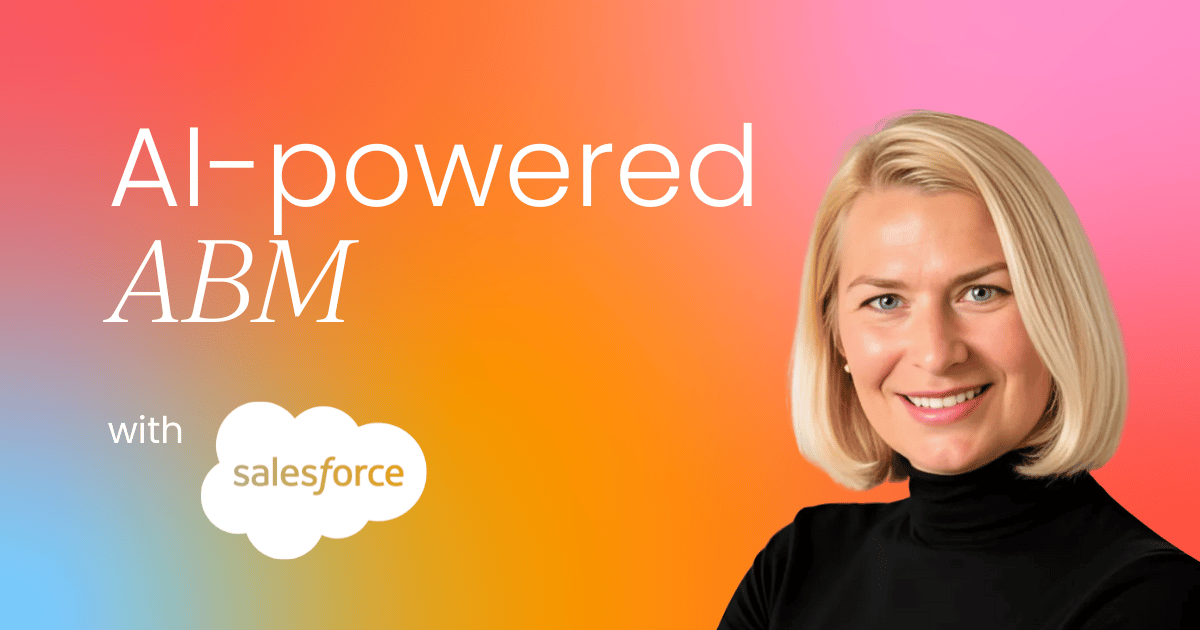This article is based on Joanna Moss’s insightful presentation at the ABM Summit. As an RMA member, you can enjoy the complete recording here.
Thanks to the rise of AI, the way we approach account-based marketing (ABM) is changing – fast. We’re seeing new possibilities for how we work, plan, and measure success.
In this article, we’ll dig into how AI is transforming ABM and explore:
- The current state of ABM and how it’s evolving in the AI-driven era
- How AI is being used to research accounts and fine-tune segmentation
- Ways AI helps align sales and marketing teams more effectively
- AI-driven measurement tools that show real impact
- Practical steps to get started with your own AI-powered ABM journey
By the end, you’ll have fresh ideas and actionable takeaways to start leveraging AI in your ABM strategy and prove its value to your leadership team.
The rise of AI in ABM
There’s no denying it – AI is everywhere. It’s disrupting marketing organizations and unlocking huge potential, from saving time to creating more personalized customer experiences. According to our research, 71% of marketers believe generative AI will free them up to focus on more strategic work.
For us at Salesforce, time is one of the most valuable resources, and AI is helping us get more of it back. Tasks that used to take hours – like analyzing campaign data, writing briefs, building audience segments, and mapping out customer journeys – can now be streamlined with the help of generative AI.
With a marketer involved at every step, we’ve seen significant time savings. Many marketers are saying they’re reclaiming up to a week’s worth of work, letting them focus on high-impact, strategic efforts instead.
Attitudes toward AI adoption in ABM
While the promise of AI is exciting, many marketers are still figuring out where to start – especially in ABM. Some teams have tried tools like ChatGPT for content creation, but other applications – like project management, collaboration, and workflows – are still untapped.
The latest ABM Benchmarking Survey from Inflexion Group reflects this. While many marketers are already experimenting with AI for text-based content, areas like customer experience, influencer marketing, and project workflows remain underutilized. This highlights an opportunity to push AI’s boundaries in ABM.
At Salesforce, we’re experimenting with AI in several areas of our ABM program. While we’re still learning, I’m excited to share what’s working so far and offer insights to help you explore AI’s potential in your own strategies.
AI for account selection and segmentation
First, let’s dive into how AI is helping us revolutionize account selection and segmentation strategies.
At Salesforce, the start of every year brings the critical question: how do we ensure we’re focusing on the right accounts? Historically, this process could take weeks, but with AI in the mix, we’ve optimized our workflows and significantly cut down the time required.
Redefining account selection for one-to-one ABM
For one-to-one ABM, we rely on Einstein, Salesforce’s predictive intelligence tool, which integrates with our ABM coverage model. This model aligns directly with our company-wide growth strategy, ensuring the way we define our top-priority accounts is consistent and data-driven.
Einstein analyzes key factors such as:
- Open opportunities within an account
- Historical purchase patterns
- Number of Salesforce clouds in use
- Upcoming renewals
- Propensity to buy and cross-sell opportunities
All this data is fed into Einstein to generate predictive scores, rank accounts, and help us prioritize resources. These scores guide our decisions about where to invest our ABM efforts. For instance:
- Top accounts with the highest rankings fall into the “invest for growth” category, meaning they’re selected for highly personalized one-to-one ABM programs.
- Mid-ranking accounts might be placed in programmatic ABM, where personalization happens at scale but still targets top accounts with tailored activations.
Accelerating one-to-many segmentation
AI also plays a critical role in our one-to-many ABM efforts. Previously, defining target audiences, understanding their needs, and pinpointing pain points could take weeks of manual research. Now, Einstein and Data Cloud handle this heavy lifting in an instant.
By analyzing intent data, buying signals, and account insights, AI delivers pre-defined key account lists that are ready for action. This not only saves time but ensures we can move the needle with precision.
With these tools, we can automatically create segments, score accounts, and generate calculated insights for campaigns. Whether it’s preparing for major events like Dreamforce or running digital one-to-many personalized programs, AI allows us to work faster and smarter across the board.
Evolving with AI
While we’re still learning and refining these processes, the results have been transformative. AI has streamlined account selection and segmentation, saving us valuable time and making our campaigns more impactful.
Whether you're just starting with ABM or looking to scale, tools like predictive AI can help you focus your efforts on what matters most – driving growth and delivering results.
AI for sales and marketing alignment
Driving growth and building strong relationships with buyers is nearly impossible without solid alignment between sales and marketing.
When these teams aren’t working from the same CRM or using integrated tools, it becomes a major challenge. Marketing struggles to share high-value leads, and sales risks wasting time on the wrong prospects. Even worse, a lack of integration makes it difficult to uncover customer insights and track campaign performance.
At Salesforce, we’ve been tackling this challenge with AI-powered tools to keep our sales and marketing teams in sync. Here are two examples of how we’re using AI to enhance alignment and drive better results.



 Follow us on LinkedIn
Follow us on LinkedIn


